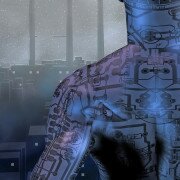Nexhuman Afterword
TDW: Exciting news, everyone. We have just re-released Livid by Francesco Verso as Nexhuman! This means a revised jacket and a new afterword written by Jana Vizmuller-Zocco, which you can read below. And don’t for get you can now get Nexhuman from your favourite retailer.
Jana: This afterword is not intended to be a conclusive statement about this remarkable novel, but to serve as a springboard for discussion about the ever-elusive definition of what it means to be human, this time from transhumanist and literary perspectives.
Transhumanism is an international philosophical and cultural movement whose main tenet is the belief in the positive outcomes of enhancing and augmenting all human faculties. The improvements go beyond simply alleviating pain or bettering one’s eyesight. They involve using prostheses, implants, nanotechnology, exoskeletons, and much more to augment human abilities beyond their natural limitations (for example, adding gills, making night vision possible, etc.). Transhumanism values reason, progress and optimism through self-determined, self-directed evolution. According to this movement, death is not inevitable and senescence can be rendered negligible.
If science fiction can be defined as works of literature that are contingent upon some as yet unfulfilled scientific advancement, transhumanist science fiction refers to those works of literature that deal with self-directed evolution, not with cyborgs created by others, but with subjects whose enhancement is directly willed by themselves.
Francesco Verso’s Nexhuman can be considered a transhumanist trailblazer in the more and more verdant forest of Italian science fiction. Although the novel does not focus specifically on self-directed evolution, the narration proceeds towards one of the crucial aspects of transhumanism – that of mind uploading. Nexhuman paints a dystopian picture of the future, where the complexities of a consumerist, profit-driven, technology-obsessed, trash-filled world, populated by humans and nexhumans, seemingly obliterate those aspects of humanity which matter most: love, identity, family, friendship and aspirations, to name just a few. However, these themes and many others find a common thread in the question of the Self: not just the basic ‘Who am I?’ but other probing queries, such as ‘Who is the Other?’, ‘How do I exist with the Other?’, ‘Where do I fit in?’, or ‘What should I do with my life?’.
Nexhuman offers a most noteworthy possibility regarding the relationship between the Self and the Other. For millennia, humans have acknowledged the fact that there exists a chasm between the Self and the Other: a binary, exclusionary relationship that separates the two fragments into clearly delineated compartments. It is true that anthropological triangulation, or double-consciousness, offers a tripartite view, but it still relies on the same components: self, other and other-self. The novel describes, in stark and nasty detail, the results of this antagonistic stance: quasi-fratricide, possible matricide, ‘nexhuman-cide’, exclusion (seen in the character of Ion) and separation (human vs. nexhuman; male vs. female). Peter Payne attempts to avoid falling into the trap of hate even when he is bent on vendetta. He falls in love with a being he does not know is a nexhuman, and he keeps loving her even after finding out that she is a copy of a sixty-year-old woman’s mind that has been uploaded. His search for Alba’s severed pieces symbolises his quest to find himself – but not at the cost of excluding others. And here is the point at which transhumanism’s mind-uploading technology shows yet another possibility, clearly illustrated in the novel: to live as Self within the Other(s). The Self can be uploaded into any form (human or not), of any age, and this can be done many times over – just as Alba’s example shows. The Self can live within other people’s memories: Peter Payne uploads his own memories into the program of his mother’s hologram, where she will live on. However, the most inclusive sense of the Self within the Other is Peter’s feeling that Alba lives within him. Of course, these serious aspects of the ‘payneful’ experience receive good doses of irony (specifically: love growing out of a trash-filled environment; trash-forming and recycling of garbage, but also of mind; Peter’s approval to upload his mind not because of his mutilated, bruised body, but on account of love; etc.).
Therefore, the Self and the Other(s) are categories that are not exclusive, but are subsumed within each other: the new consciousness of both Peter and Alba are not simply imagined but embodied, not dreamt but uploaded. There is no antagonism between the Self and the Other(s), nor are there blurred, indistinct outlines. They are enclosed, experienced, practiced, familiar and deeply felt. They are not fluid but embraced, and readily received.
Frederick Pohl, the American science fiction writer, claimed that, ‘A good science fiction story should be able to predict not the automobile but the traffic jam.’ Nexhuman’s traffic jams include the usual problems encountered not only in science fiction – extreme environmental degradation, unscrupulous employers, failure to stop aggressive and violent behaviour – but also those created by new transhumanist technologies, such as self-constructed bodies, mind uploading, misuse of mind-transforming technologies, inability to educate the young, and wide gaps between humans and nexhumans. The novel does much more than this since it redefines the relationships between the Self and the Other(s), offering a new way of being human: that of embracing one Self within the Other(s).









